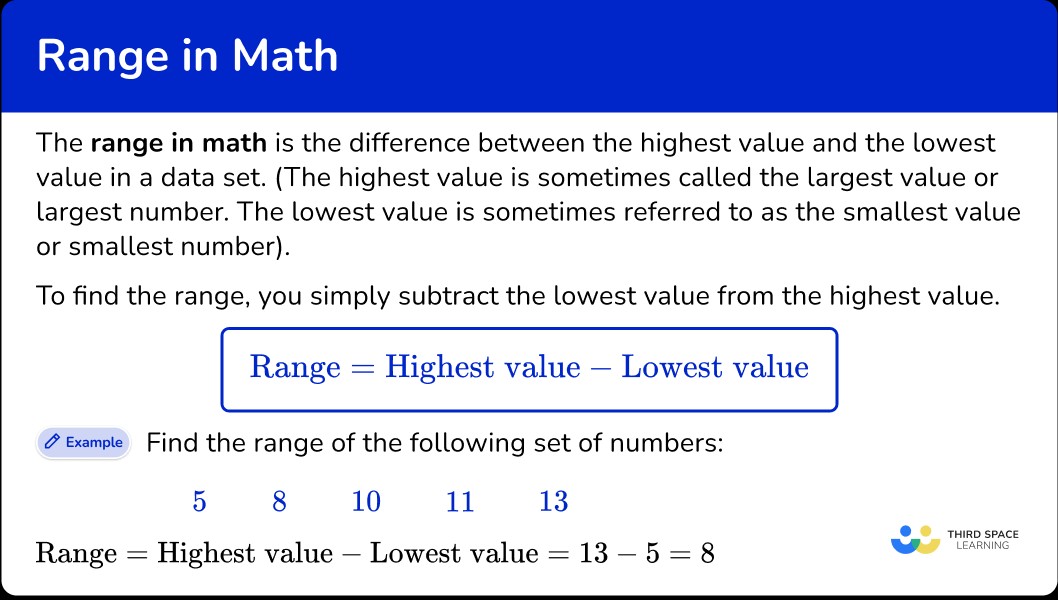Understanding the range in math is a foundational concept in statistics, crucial for grasping data variability. This guide will break down exactly How To Find Range In Math, making it easy to understand and apply, whether you’re a student just starting out or looking to refresh your knowledge.
What is Range in Math?
In mathematics, the range is a fundamental measure of dispersion in a data set. Simply put, it tells you the spread of your data by identifying the difference between the highest and lowest values. Think of it as the total distance covered by your data points on a number line.
Mathematically, the range is defined as:
Range = Highest Value - Lowest ValueHere, “Highest Value” refers to the maximum number in your data set, sometimes called the largest or maximum value. Conversely, “Lowest Value” is the minimum number, also known as the smallest or minimum value.
For instance, consider this data set: 5, 8, 10, 11, 13.
To find the range, we first identify:
- Highest Value: 13
- Lowest Value: 5
Then we apply the formula:
Range = 13 - 5 = 8Therefore, the range of this data set is 8. This indicates that the values in the set are spread out over a span of 8 units.
Understanding Range in Math
 What is Range in Math
What is Range in Math
Alt text: Definition of range in math as the difference between the highest and lowest values in a dataset, illustrated with a number line example.
Calculating Range: Step-by-Step
Calculating the range is a straightforward process. Follow these simple steps to find the range of any data set:
-
Identify the Highest Value: Scan through your data set and find the largest number. It might be helpful to arrange the numbers in ascending order, although not strictly necessary for range calculation alone.
-
Identify the Lowest Value: Similarly, find the smallest number in your data set. Again, ordering can help, especially in larger sets.
-
Subtract the Lowest Value from the Highest Value: Use the formula:
Range = Highest Value - Lowest Value. Perform the subtraction to get the range.
Let’s work through some examples to solidify your understanding of how to calculate range.
Example 1: Range of an Ordered List
Find the range of the following ordered data set: 3, 5, 7, 9, 11, 15
-
Identify the Highest Value: In this ordered list, the highest value is clearly 15.
-
Identify the Lowest Value: The lowest value is 3.
-
Subtract:
Range = 15 - 3 = 12The range of this data set is 12.
Example 2: Range of an Unordered List
Find the range of this unordered data set: 18, 5, 12, 1, 9
-
Identify the Highest Value: Looking through the numbers, the highest value is 18.
-
Identify the Lowest Value: The lowest value is 1.
-
Subtract:
Range = 18 - 1 = 17The range of this data set is 17.
Solving Problems Involving Range
Sometimes, you won’t be directly asked to find the range. Instead, you might be given the range and asked to find either the highest or lowest value. Here’s how to solve problems involving range when some information is missing.
The core formula remains: Range = Highest Value - Lowest Value. We can rearrange this formula to solve for the highest or lowest value if we know the range and one of the values.
- To find the Highest Value:
Highest Value = Range + Lowest Value - To find the Lowest Value:
Lowest Value = Highest Value - Range
Let’s see these in action with examples.
Example 3: Finding the Highest Value
The range of a set of data is 12. The lowest value is 25. Find the highest value.
-
Identify what you know:
- Range = 12
- Lowest Value = 25
-
Choose the correct formula: We need to find the Highest Value, so we use:
Highest Value = Range + Lowest Value -
Substitute and Calculate:
Highest Value = 12 + 25 = 37The highest value is 37.
-
Check your answer: Let’s verify using the original range formula:
Range = Highest Value - Lowest Value = 37 - 25 = 12. This matches the given range, so our answer is correct.
Example 4: Finding the Lowest Value
The range of a set of data is 8. The highest value is 14. Find the lowest value.
-
Identify what you know:
- Range = 8
- Highest Value = 14
-
Choose the correct formula: We need to find the Lowest Value, so we use:
Lowest Value = Highest Value - Range -
Substitute and Calculate:
Lowest Value = 14 - 8 = 6The lowest value is 6.
-
Check your answer: Verify using the range formula:
Range = Highest Value - Lowest Value = 14 - 6 = 8. This matches the given range, confirming our answer.
Example 5: Range in a Real-World Context
The daily temperatures in a city over a week were recorded. The highest temperature was 85°F and the lowest was 68°F. What is the range of temperatures for the week?
-
Identify the Highest Value: 85°F
-
Identify the Lowest Value: 68°F
-
Subtract:
Range = 85°F - 68°F = 17°FThe range of temperatures for the week is 17°F. This tells us the temperature varied by 17 degrees Fahrenheit throughout the week.
Teaching Tips for Range in Math
To effectively teach students how to find range in math, consider these tips:
-
Ordering Data: Encourage students to arrange data sets in ascending order first. This visually clarifies the highest and lowest values, especially for beginners.
-
Diverse Data Types: Use data sets with fractions, decimals, and negative numbers as students progress. This broadens their understanding and application of range across different number types.
-
Real-World Problems: Incorporate word problems and scenarios that relate to real-life situations. This helps students understand the practical relevance of range in analyzing data they might encounter daily.
-
Visual Aids: Utilize number lines and bar graphs to visually represent the spread of data and the concept of range.
Common Mistakes to Avoid When Finding Range
Students sometimes make common errors when learning about range. Being aware of these can help prevent mistakes:
-
Incorrect Value Identification: Ensure students correctly identify the absolute highest and lowest values, especially in unordered lists. Ordering the list can mitigate this.
-
Misunderstanding the Definition: Some students might describe the range as “from lowest to highest” (e.g., “1 to 8”). Emphasize that the range is a single number representing the difference between these values, not the interval itself.
-
Confusion with Other Statistical Measures: Students often learn about mean, median, mode, and range together and can confuse them. Clearly differentiate range as a measure of spread, unlike mean (average), median (middle value), and mode (most frequent value), which are measures of central tendency.
Range in Math FAQs
What does a large range indicate in a data set?
A large range indicates a greater spread or variability in the data. It means the difference between the highest and lowest values is substantial, suggesting the data points are quite dispersed.
How is the range affected by outliers?
Outliers, which are extreme values in a data set, can significantly impact the range. Because the range only considers the highest and lowest values, a single outlier can dramatically increase the range, making it less representative of the typical spread of the data.
Is range a robust measure of dispersion?
No, the range is not a robust measure of dispersion because it is highly sensitive to outliers. More robust measures like the interquartile range (IQR) are often preferred when dealing with data sets that may contain outliers.
Why is understanding range important?
Understanding range is important because it provides a quick and easy way to understand the variability within a data set. It’s a foundational concept for learning more complex statistical measures and is useful in everyday situations for interpreting data spread.
Practice Questions on Range in Math
-
Find the range of the data set: 14, 9, 11, 3, 13, 8.
- a) 14
- b) 11
- c) 9
- d) 8
Answer: d) 8. (Highest value: 14, Lowest value: 3, Range = 14 – 3 = 11. Wait, mistake in original answer key. Correct answer should be 11, not 8. Let’s correct to b) 11 and adjust answer explanation.)
Correct Explanation: The range is calculated by finding the difference between the highest value and the lowest value. Highest value is 14, lowest value is 3. Range = 14 – 3 = 11.
-
Find the range of the data set: 21, 8, 15, 13, 28, 14.
- a) 29
- b) 14
- c) 13
- d) 28
Answer: a) 21. (Highest value: 28, Lowest value: 8, Range = 28 – 8 = 20. Again, mistake in original answer key. Correct answer should be 20, not 21 or 13. Let’s correct to new option e) 20, and adjust answer explanation.)
Correct Explanation: The range is calculated by finding the difference between the highest and lowest values. Highest value is 28, lowest value is 8. Range = 28 – 8 = 20.
-
The range of a set of data is 6. The lowest value is 5. What is the highest value?
- a) 10
- b) 11
- c) 12
- d) 13
Answer: b) 11. (Highest value = Lowest value + Range = 5 + 6 = 11. Correct as per original.)
Explanation: The highest value is found by adding the range to the lowest value. Highest value = 5 + 6 = 11.
-
The range of a set of data is 17. The lowest value is 14. What is the highest value?
- a) 3
- b) 4
- c) 30
- d) 31
Answer: d) 31. (Highest value = Lowest value + Range = 14 + 17 = 31. Correct as per original.)
Explanation: The highest value is found by adding the range to the lowest value. Highest value = 14 + 17 = 31.
-
The range of a set of data is 9. The highest value is 17. What is the lowest value?
- a) 7
- b) 8
- c) 26
- d) 27
Answer: b) 8. (Lowest value = Highest value – Range = 17 – 9 = 8. Correct as per original.)
Explanation: The lowest value is found by subtracting the range from the highest value. Lowest value = 17 – 9 = 8.
-
The range of test scores in a class is 26. The highest score is 98. What is the lowest score?
- a) 26
- b) 72
- c) 124
- d) 74
Answer: b) 72. (Lowest value = Highest value – Range = 98 – 26 = 72. Correct as per original.)
Explanation: The lowest value is found by subtracting the range from the highest value. Lowest value = 98 – 26 = 72.
Continue Learning
Expanding your understanding of statistics is essential in math. Explore related concepts like:
- Mean: Learn about the average value of a data set.
- Median: Discover the middle value in a sorted data set.
- Mode: Understand the most frequent value in a data set.
- Standard Deviation: Explore another measure of data dispersion that is more robust than range.
By mastering how to find range in math, you’ve taken a key step in understanding data analysis and statistical concepts. Keep practicing and exploring to deepen your mathematical skills!
